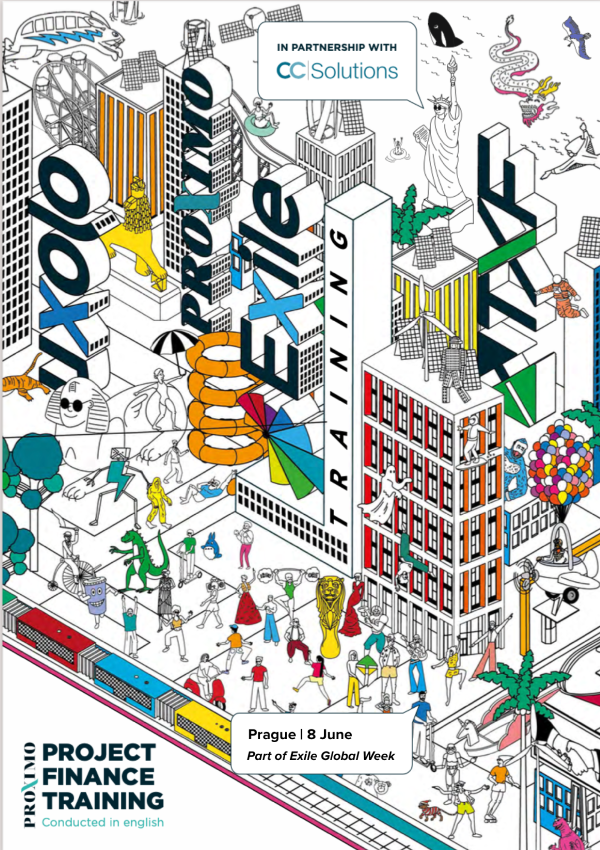Private credit: Is this infrastructure’s new liquidity pocket?
Private credit - the hot new trend in corporate and leveraged lending - might have applications in project and infrastructure finance. But it’s part of a much longer trend in non-bank lending for long-lived real assets.

Blackstone’s president calls 2023 a “golden moment” for private credit. BlackRock compares the evolution of private credit to the introduction of the iPhone as a pivotal moment in financial markets. The larger US investment banks are boosting their capabilities in trading and advising on private credit transactions. And institutional investors are increasing their allocations to private credit.
The main thesis behind the growth of private credit is that recent rises in interest rates and longer-term regulatory constraints have combined to reduce the capacity of the bank market to meet borrowers’ needs. As far the project finance market is concerned, these trends are a combination of old and new news.
Rising interest rates are a relatively new phenomenon, though even now they are only approaching levels seen in 2007 on the eve of the last Great Financial Crisis, if measured using the Federal Funds Rate. The regulatory stimulus has been a much longer time coming - since a first proposal to revise the Basel capital adequacy rules in 1999.
But the idea that banks are not the obvious and natural home for long-dated loans to infrastructure assets has a long pedigree, and the last two decades feature numerous official and unofficial attempts to make project finance assets more palatable to non-bank lenders, or to make non-bank lenders more welcoming to project finance assets.
Listing them all would be a long and arduous process, but a non-exhaustive list would include project bond guarantees (public and private), term B loans, project finance debt funds, bond insurance, infrastructure collateralised loan obligations, bilateral credit insurance and the evolution of private placements. Not all of them can be discussed and defined, though some of them can conceivably fall under the heading of private credit.
Definitions and documentation
But it probably makes sense to try and define private credit. First there is the minimalist view. “I would say that strictly speaking it’s a private equity firm lending to a mid-market firm for five years at an all-in rate of 12%”, suggests a senior debt fund manager. A primer from UBS suggests that that kind of financing is best defined as a subset of private credit called direct lending. Unhelpfully, the primer does not mention private credit in the context of infrastructure assets at all.
Then there’s the maximalist view. “I’d say it is any debt product that is not traded and not provided by banks,” suggests Jeremy Allcock, Abrdn’s head of infrastructure debt, “though it might be provided alongside banks.” This places the starting point in the evolution of private credit not in 1999 but in 2008, when banks suddenly faced higher funding costs and ruined balance sheets in the wake of the GFC.
“Private credit in infrastructure really took off after the 2008 crisis, when banks became constrained in their ability to provide alternative financing. With the arrival of new themes such as energy transition and digitalisation, which have added breadth and scale to the infrastructure market, a higher-yield proposition also became more apparent, encompassing both senior and subordinated debt lending opportunities,” suggests Matt Dimond, managing director and head of client capital at Sequoia Investment Management, which runs a listed infrastructure debt fund that makes unlisted loans.
There’s a definite trans-Atlantic divide to these definitions. In Europe, where banks are generally more dominant in lending, non-bank lending is a more recent phenomenon. In the US insurance companies have been refinancing construction project finance loans for power plants with private placements since at least the 1990s. And for the last 15 years power sponsors have typically raised debt from non-bank lenders in the leveraged loan (more commonly known as term B loan) market. As a result, in the US it is more common to define private credit more narrowly.
It might be a little unsatisfying, but a good way of thinking about private credit is perhaps in terms of the places in a project’s capital structure that it is occupying and why other providers are not able to play there, and what providers expect to make from their product. “Private Credit is often associated only with the higher risk-return strategies, where target returns are typically somewhere between debt and equity funds,” suggests Jorge Camiña, partner and head of Denham Capital’s $2 billion sustainable infrastructure credit business. There is, for the wrong assets, in the wrong places, at the wrong time, often a huge gulf between what pure equity can afford to contribute and what senior debt is willing to do.
Beth Waters, a managing director in MUFG’s Americas project finance group, suggests that there are likely to be constraints on some banks’ ability to commit to fund deals in the 4th quarter of 2023. “In addition to most banks’ cost of capital having gone up this past year, many lenders have also started having balance sheet constraints and, thus, they can only book so much business. Private credit providers are available and able to fill any potential gap - but at a higher cost - and if some developers who are struggling to get funding before year end cannot wait until banks’ balance sheets free up in 2024, then they may need to access these providers.”
Debt funds have struggled to compete in the conventional renewables sector as margins are typically lower than other project finance sectors such as LNG and quasi-merchant gas-fired projects. If you’re a large renewables developer, with a strong and solid balance sheet or with generous support from a vast financial sponsor, developing a contracted portfolio of projects in supportive power markets, banks will generally happily open their books. However, the pre-2008 market norm of deals with fully amortising tenors out to 18 years was replaced with 5-7 year mini-perms (although with amortisation schedules still going out to 18 years) provided on a club basis, says Waters.
The non-bank lending pedigrees
In the US there is a fairly rich history of non-bank funds that are willing to look at riskier credits. TCW launched a project finance fund in 2000, and it continues as part of EIG Partners’ offering. EIF, now part of Ares, offered subordinated development loans. Carlye launched the Carlyle Energy Mezzanine Opportunities Fund in 2010 before discontinuing the product nine years later.
In 2019, Starwood Property Trust bought GE Energy Financial Services' project finance debt business and loan portfolio, which included $400 million of unfunded loan commitments, for $2.56 billion. Starwood said the acquisition would complement its existing energy equity and real estate equity and debt businesses. Starwood funded the acquisition with a combination of a $1.7 billion bridge from MUFG and cash and corporate credit facility capacity on hand.
The business fits most of the definitions of private credit. The loans are certainly short enough, with a weighted average life of just over four years, according to an August 2021 presentation. And they are senior secured, giving Starwood fast access to underlying assets. But they are primarily floating rate, and produce an unlevered yield of just under 5%.
Another big difference: in August 2021 Starwood’s infrastructure portfolio was 59% loans to gas-fired power plants, which are becoming much less popular with commercial banks. Much as debt funds have become more important to upstream oil & gas producers because of banks’ ESG constraints, they are likely to be more important to fossil-fired power generators.
Starwood completed a debut securitisation for the project finance portfolio in March 2021, the $500 million MUFG-structured STWD 2021-SIF1. The issue comprised $300 million of Aaa notes priced at 150bp over Libor, a $50 million Aa3 tranche at 190bp, $25 million of A3 notes carrying 235bp pricing, $35 million of Baa3 notes for 390bp, and $90 million in equity.
The deal breathed a little life into the market for collateralised loan obligations backed by project financed assets. It paralleled the efforts of Bayfront Infrastructure, the lending platform backed by the Singaporean government, and DWS, the German asset manager, to expand the project CLO market. Indeed in June DWS closed a $261 million sixth CLO, RIN VI, hot on the heels of announcing it would start making infrastructure debt products available to retail investors.
New avenues in insurance distribution
The oldest means of recycling project finance debt, at least in the US, was typically via a project-level private placement or 144A bond, with life insurance companies making up the overwhelming majority of the investor base until maybe 15 years ago, and serving as dominant players even today. More recently, CLOs offered some ways for banks to recycle their portfolio.
But more recently a different corner of the insurance market, trade credit insurers, have taken on greater importance in private bilateral insurance of either individual loans or parts of banks’ portfolios. Ratings agencies, almost visibly relieved to be reducing their dependence on borrowers for fee income, are supporting these transactions enthusiastically. But this is private credit insurance rather than private credit.
Something of a hybrid approach between credit insurance and private placements comes in the distribution strategies adopted by the big asset management firms for their so-called “unitranche” financings. These essentially replace the raft of borrower-facing tranches - each with a slightly different security and cashflow position - with a single facility that the lender then turns round and distributes according to its own priorities and schedules.
One common strategy for unitranche lenders has been to use feeder funds to retranche the bulk of a loan into a tranche that is investment grade and senior secured, and therefore more appealing to insurance companies. However, notes one lender, the National Association of Insurance Commissioners is looking at increasing the capital charges that insurers must apply to private credit tranches, even rated ones, since these may sometimes look a little like equity interests.
While there has been some pushback against the proposals, not least from ratings agencies, it is possible that these highly engineered structures might fall out of favour relative to formal bond structures. Both the large generalist infrastructure equity and debt funds and the specialist debt funds have been offering unitranche products, with the big generalist funds willing to occupy large parts of the capital structure, but one specialised debt fund manager cautions that they are still generally pulling debt and equity capital from different sets of limited partners. Another lender says “even the largest and most established private equity firms generally will not be able to do 100% of a deal’s capital requirements.”
Meanwhile banks are probably more keen to do longer-dated deals with familiar technologies and sponsors than look at supporting unproven technologies for smaller sponsors. “The idea that institutional investors would take on the lower risk credits, leaving banks free to support more cutting edge technologies, has not really panned out,” remarks one lender. Unlike 2008, and despite the well-publicised failures of Silicon Valley Bank and Credit Suisse (the latter was a pioneer in raising debt from non-bank lenders), banks are better positioned to defend their lending franchises from institutions.
A new name for captive finance
One example of private credit innovation comes from a more surprising corner of the capital markets - in the historically less glamorous business of providing financing for equipment suppliers. Current stock market wisdom does not encourage large manufacturers to put their balance sheets to work to facilitate sales.
Energy transition-related requirements, whether converting coal-fired power plants to run on gas, install battery storage, or procuring electrolysers for green hydrogen projects, will create huge demand for the output of the larger manufacturers. Demand may be strong enough that they can demand large progress payments from their larger customers. For the smaller or riskier developers, some sort of vendor finance package, whether senior or subordinated, might be necessary.
These financing products have particular appeal for smaller and/or riskier developers, for which that kind of package, whether senior or subordinated, can serve as one-stop-shop for large purchases. A private credit specialist will be more willing to support such financings in a programme with the higher credit quality global suppliers, targeting 9-12% rates of return
The founder of eight-year-old Industrial Development Funding (IDF), former GE executive Nik Nunes, has an expansive definition of private credit for a US lender - “the range of non common-equity products, from preferred equity, to mezzanine, to subordinated debt, to stretch senior debt and unitranches,” he says - though IDF focuses on two products: private debt funding for large global suppliers’ product sales and funding for their derivative product development.
IDFs product development funding looks particularly private credit-like, since given that the lender shares in product development and revenue generation risk on a non-recourse basis, it can receive returns in the 12-14% range. Established direct lending specialists such as the Blackstone Private Credit Fund are heavily focused on growth sectors such as technology, though usually on more of a corporate basis.
IDF is a fundless sponsor, which assembles groups of debt providers, including MUFG, Mizuho, CDPQ, HPS and BAWAG. Its focus has predominantly been on product sales funding and it has deployed $1.8 billion in financing, of which $750 million supported a little over $1.5 billion in sales of Mitsubishi Power’s large gas turbines and other large capex items to investment grade generators and utilities. According to Proximo’s data, IDF put together a $244 million debt facility in support of a sale of generating equipment to a large US utility.
The rest has supported a programme of sales of refurbished aeroderivative gas turbines to Wattbridge, a developer of grid reliability-focused fast power plants. Wattbridge has raised senior secured and holdco financing from MUFG, HPS and EIG to install about 40 refurbished GE LM6000 units with a total capacity of over 2,000MW in Texas, and has done so during some of the tightest power markets the state has ever experienced.
Nunes sees another opportunity for private credit providers in the digital infrastructure sector, where the deployment of artificial intelligence and machine learning solutions will require huge investments in associated infrastructure, with similar risk and return dynamics to the energy transition and heavy infrastructure. This is an area where providing 10-14% returns to private credit lenders will be attractive to cloud and data centre operators relative to the use of scarce venture capital funding.
The Proximo perspective
The story of new non-bank forms of debt over the last two decades is that they emerge, or are born of necessity, at times of severe market disruptions. They are most useful when traditional providers have to pull back, and when sponsors are forced to pay higher prices for their debt.
Some stick around, for instance the term B market, which is no longer the dominant force in US power, but tends to cap the returns that other debt providers can make there. Others, like the unlamented payment-in-kind lenders, are very scarce in 2023.
Private credit - defined loosely as earning 12% for five-year debt featuring unconventional structures - has yet to prove it has staying power. Perhaps because project finance transactions may not be able to accommodate that pricing and those structures for long. Or because investors in private credit funds will decide they make better returns from loan-to-own transactions for distressed consumer goods manufacturers and retailers.
But private credit was not a major player in financial markets when interest rates were last at elevated levels, and the infrastructure - a universe of specialist third-party administrative and paying agents - was not around to support it. It will probably need an extended period of time and exposure to a larger variety of borrowers to prove it is relevant to the infrastructure market.
And finally, a little perspective. According to Proximo’s last full-year of data, the global project finance market in 2022 comprised $432.2 billion of transactions. According to Sequoia’s Dimond, “infrastructure private credit funds account for around $150 billion in assets under management. The equivalent allocation to infrastructure private equity funds is probably nearer $1 trillion, over six times the credit fund market. While equity fund allocations are estimated to have been growing at over 15% annually in recent years, private credit fund allocations have been growing at closer to 30%. Catching up will take some time, suggesting there will be a period of sustained demand for the credit product.”





